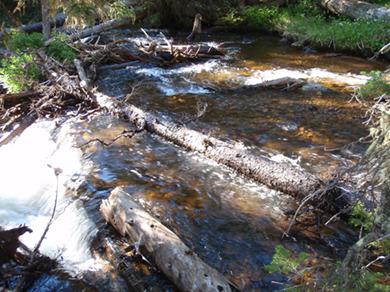当前位置:
X-MOL 学术
›
Hydrol. Process.
›
论文详情
Our official English website, www.x-mol.net, welcomes your feedback! (Note: you will need to create a separate account there.)
The Resilience of Logjams to Floods
Hydrological Processes ( IF 3.2 ) Pub Date : 2020-11-18 , DOI: 10.1002/hyp.13970 Ellen Wohl 1 , Julianne E. Scamardo 1
Hydrological Processes ( IF 3.2 ) Pub Date : 2020-11-18 , DOI: 10.1002/hyp.13970 Ellen Wohl 1 , Julianne E. Scamardo 1
Affiliation

|
Correspondence Ellen Wohl, Department of Geosciences, Colorado State University, Fort Collins, CO 80523-1482, USA. Email: ellen.wohl@colostate.edu Abstract Logjams that span the bankfull channel strongly influence hydraulics and downstream fluxes of diverse materials. Several studies quantify the longitudinal distribution of channel-spanning logjams, but fewer studies examine changes in longitudinal distribution in response to disturbances such as floods. We use 10 years of annual surveys of a population of channel-spanning logjams along mountain streams in the Southern Rocky Mountains. Surveys from 2010 to 2019 bracket substantial interannual variability in the snowmelt peak flow as well as a rainfall flood in 2013. We characterised the number of logjams per unit length of valley (logjam distribution density) within and between reaches designated based on longitudinally consistent channel and valley geometry. Our primary objectives are to evaluate the influences on logjam distribution density of (i) spatial variations in valley and channel geometry and (ii) temporal variations in peak annual flow. We hypothesized that logjam distribution densities are resilient to disturbance at both spatial scales. At the creek scale, logjam distribution density correlates significantly with increasing ratio of floodplain width to channel width and wood piece length to channel width. Wide, low gradient reaches with greater distribution density exhibit greater interannual variation in distribution density. These reaches lost jams during the 2013 flood but returned to pre-flood distribution density values by the end of the study. The pattern of greater logjam distribution density in unconfined reaches relative to confined and partially confined reaches is also consistent over the period of the study. We interpret these results as indicating the resilience of logjam distributions to disturbance. The persistence of greater numbers of logjams in wide, low gradient reaches suggests that river restoration employing engineered logjams and wood reintroduction can focus most effectively on these reaches.
中文翻译:

僵局对洪水的抵御能力
通讯作者 Ellen Wohl,科罗拉多州立大学地球科学系,柯林斯堡,科罗拉多州 80523-1482,美国。电子邮件:ellen.wohl@colostate.edu 摘要 横跨满岸通道的堵塞强烈影响水力学和不同材料的下游通量。几项研究量化了跨渠道僵局的纵向分布,但很少有研究检查纵向分布的变化以响应洪水等干扰。我们使用了 10 年的年度调查,对南落基山脉山涧沿线的跨渠道僵局人口进行了调查。2010 年至 2019 年的调查显示,融雪峰值流量和 2013 年的降雨洪水存在显着的年际变化。我们描述了基于纵向一致的河道和山谷几何形状指定的河段内和河段之间每单位长度的山谷的堵塞数量(堵塞分布密度)。我们的主要目标是评估 (i) 山谷和河道几何形状的空间变化和 (ii) 峰值年流量的时间变化对堵塞分布密度的影响。我们假设僵局分布密度对两个空间尺度的干扰都有弹性。在小溪尺度上,原木分布密度与洪泛区宽度与河道宽度和木片长度与河道宽度之比的增加显着相关。分布密度较大的宽、低梯度河段显示分布密度的较大年际变化。这些到达在 2013 年洪水期间丢失的堵塞,但在研究结束时恢复到洪水前的分布密度值。在研究期间,相对于封闭和部分封闭河段,未封闭河段中更大的堵塞分布密度模式也是一致的。我们将这些结果解释为表明僵局分布对干扰的弹性。在宽阔、低坡度的河段持续存在更多的僵局表明采用工程僵局和木材重新引入的河流修复可以最有效地集中在这些河段。我们将这些结果解释为表明僵局分布对干扰的弹性。在宽阔、低坡度的河段持续存在更多的僵局表明采用工程僵局和木材重新引入的河流修复可以最有效地集中在这些河段。我们将这些结果解释为表明僵局分布对干扰的弹性。在宽阔、低坡度的河段持续存在更多的僵局表明采用工程僵局和木材重新引入的河流修复可以最有效地集中在这些河段。
更新日期:2020-11-18
中文翻译:

僵局对洪水的抵御能力
通讯作者 Ellen Wohl,科罗拉多州立大学地球科学系,柯林斯堡,科罗拉多州 80523-1482,美国。电子邮件:ellen.wohl@colostate.edu 摘要 横跨满岸通道的堵塞强烈影响水力学和不同材料的下游通量。几项研究量化了跨渠道僵局的纵向分布,但很少有研究检查纵向分布的变化以响应洪水等干扰。我们使用了 10 年的年度调查,对南落基山脉山涧沿线的跨渠道僵局人口进行了调查。2010 年至 2019 年的调查显示,融雪峰值流量和 2013 年的降雨洪水存在显着的年际变化。我们描述了基于纵向一致的河道和山谷几何形状指定的河段内和河段之间每单位长度的山谷的堵塞数量(堵塞分布密度)。我们的主要目标是评估 (i) 山谷和河道几何形状的空间变化和 (ii) 峰值年流量的时间变化对堵塞分布密度的影响。我们假设僵局分布密度对两个空间尺度的干扰都有弹性。在小溪尺度上,原木分布密度与洪泛区宽度与河道宽度和木片长度与河道宽度之比的增加显着相关。分布密度较大的宽、低梯度河段显示分布密度的较大年际变化。这些到达在 2013 年洪水期间丢失的堵塞,但在研究结束时恢复到洪水前的分布密度值。在研究期间,相对于封闭和部分封闭河段,未封闭河段中更大的堵塞分布密度模式也是一致的。我们将这些结果解释为表明僵局分布对干扰的弹性。在宽阔、低坡度的河段持续存在更多的僵局表明采用工程僵局和木材重新引入的河流修复可以最有效地集中在这些河段。我们将这些结果解释为表明僵局分布对干扰的弹性。在宽阔、低坡度的河段持续存在更多的僵局表明采用工程僵局和木材重新引入的河流修复可以最有效地集中在这些河段。我们将这些结果解释为表明僵局分布对干扰的弹性。在宽阔、低坡度的河段持续存在更多的僵局表明采用工程僵局和木材重新引入的河流修复可以最有效地集中在这些河段。


























 京公网安备 11010802027423号
京公网安备 11010802027423号